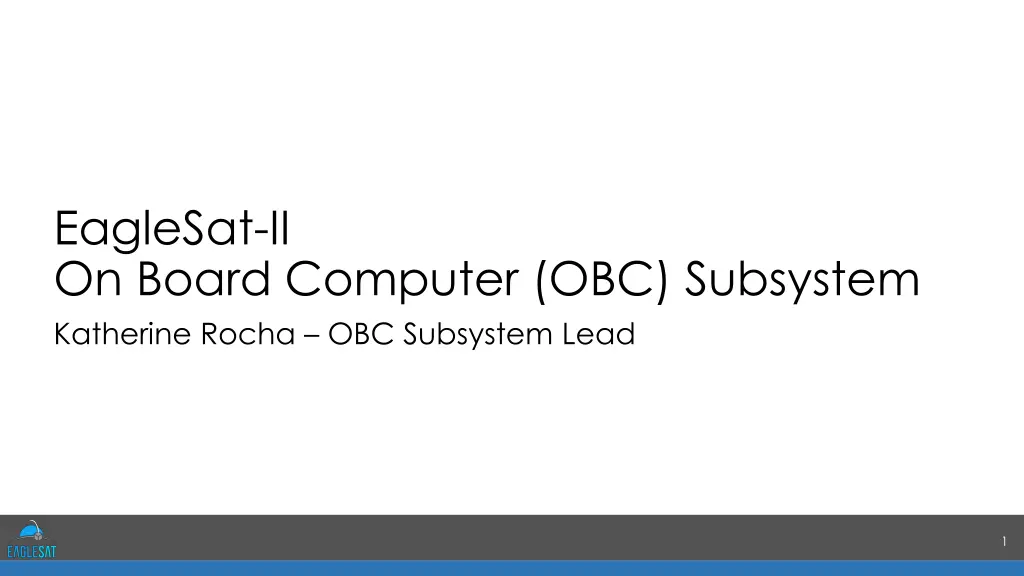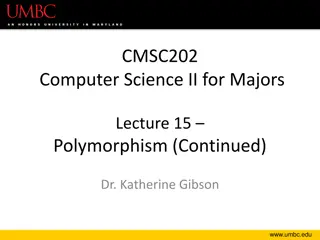
EagleSat-II On-Board Computer (OBC) Subsystem Overview
Discover the architecture of the EagleSat-II OBC Subsystem led by Katherine Rocha, featuring FPGA fabric, MicroBlaze soft processing core, and centralized computer system with Triple Mode Redundancy for radiation protection. Learn about the ease of development for the team, firmware priorities, additional telemetry options, and the role of the MicroBlaze SoftCore in connecting subsystems and processing data. Explore how the OBC communicates with ground systems and handles payload data efficiently.
Download Presentation

Please find below an Image/Link to download the presentation.
The content on the website is provided AS IS for your information and personal use only. It may not be sold, licensed, or shared on other websites without obtaining consent from the author. If you encounter any issues during the download, it is possible that the publisher has removed the file from their server.
You are allowed to download the files provided on this website for personal or commercial use, subject to the condition that they are used lawfully. All files are the property of their respective owners.
The content on the website is provided AS IS for your information and personal use only. It may not be sold, licensed, or shared on other websites without obtaining consent from the author.
E N D
Presentation Transcript
EagleSat-II On Board Computer (OBC) Subsystem Katherine Rocha OBC Subsystem Lead 1
OBC Overview Architecture Description FPGA Fabric MircoBlaze Soft Processing Core 2
Architecture Description Figure 1: System-Level Block Diagram 3
Architecture Description Centralized computer system Triple Mode Redundancy solution to radiation Distributed FPGA Fabric Payload instruments (cameras and RAM) and some telemetry instruments have logic elements Processes all payload data and reports to MicroBlaze Developed in-house MicroBlaze SoftCore Connects to all other subsystems, through FPGA Fabric Processes all bus system data and telemetry Communicates with the ground through COMMS subsystem 4
FPGA Fabric Overview Ease of development for the team critically important Design is optimal for a state machine FPGA with softcore to meet instrument timing requirements 5
FPGA Fabric Firmware Ease of development a priority Payload software being developed by each payload subteam independently No need for high-overhead complex solution Simple cyclic executive with interrupts 6
FPGA Fabric Additional Telemetry Temperature sensors In-house PCBs can include as many sensors as desired routed to unused PC/104 pins Cubesat I2C bus free for use with mission-critical systems Some unoccupied PC/104 pins can be used for thermal measurements throughout cubesat structure, outside of payload stack ACS patch heater Small PCB close to ACS with power control circuitry Activated by the FPGA based on temperature measurements Comms Packet Handling Packetizes data and telemetry for downlink asynchronously 7
MicroBlaze Softcore Overview Interfaces with all other bus systems and payload stack Receives and interprets commands from the ground Designed in house Custom development for mission-critical system Main + ISR design like CEC222 Microprocessor Systems Lab Students already understand the basic design 8
MicroBlaze Firmware Using Xilinx IP and example code to create the softcore External interfaces adjusted to work with Neso Artix 7 Custom PDL with interfaces to FPGA Off-loading processing to FPGA fabric 9
MicroBlaze Flight Software (FSW) Main + ISR design Minimal interrupts Priority is power Simple software loop with timer interrupt for instrument control Data will be retrieved via polling 10
MicroBlaze Software Operating Modes Detumble Entered at every boot, all subsystems off except OBC and ACS ACS detumbling the spacecraft until low rotation rate Safe mode Spacecraft reduced to barebones operation Payloads off, COMMS attempts to establish communication with ground station Normal operating mode Main science mission underway Payloads fully operating, ACS stationkeeping Figure 7: EagleSat-II Operating Modes 11
On-Board Computer Board Design Prototype PCB early in design/build process Parts and interfaces selected, early schematic designs Pin and peripheral assignments planned, subject to change MDE prototype already running on TM4C Black box test of descaled system during high-altitude balloon flight In processing of migration to FPGA CRP prototype in development MCU + FPGA development difficult difficult to test either until both complete Prototype Complete testing being done with radiation sources 12
Questions? 13






















